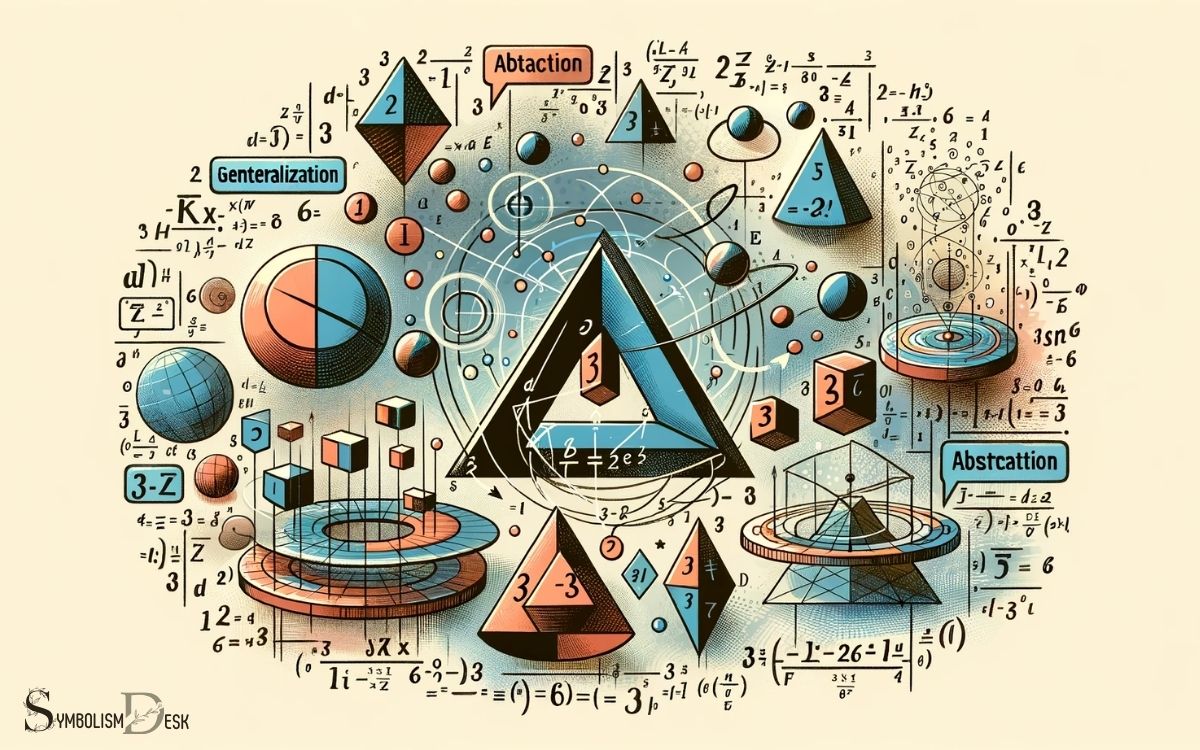What Does Symbolic Representation Mean in Math? Relations!
Symbolic representation in mathematics refers to the use of symbols to denote numbers, operations, relations, or functions, simplifying the communication and processing of mathematical ideas and problems.
Symbolic representation in mathematics is the practice of using symbols to express mathematical ideas.
Symbols can represent numbers (like ‘1’ or ‘π’), operations (such as ‘+’ for addition or ‘−’ for subtraction), relations (like ‘=’ for equality or ‘≤’ for less than or equal to), or functions (such as ‘f(x)’ for a function named ‘f’ of the variable ‘x’).
This system allows for concise and clear communication of mathematical concepts, making it easier to work with complex equations and theorems.
- Example: The quadratic formula
x = (-b ± √(b²-4ac)) / (2a)uses symbols to represent the solution to a quadratic equation.
Symbolic representation is the backbone of mathematical communication, offering clarity and precision in a universal language.

Key Takeaway
Overview of Symbolic Representations in Mathematics
| Term | Definition |
|---|---|
| Symbolic Representation | The use of symbols in mathematics to represent and communicate ideas, concepts, and relationships. |
| Symbol | A sign, character, or mark that is used to represent a specific concept, idea, or operation in mathematics. |
| Variable | A symbol that stands for an unspecified or unknown value, often denoted by a lowercase letter (e.g., x, y, or z). |
| Constant | A symbol or value that does not change or vary, often denoted by an uppercase letter (e.g., A, B, or C) or a number. |
| Operation | A symbol that denotes a specific mathematical action or process (e.g., addition, subtraction, multiplication, or division). Common operation symbols include +, -, *, and /. |
| Function | A relation between a set of inputs and a set of possible outputs, often represented by a symbol or an equation (e.g., f(x) = 2x + 3). |
| Expression | A combination of symbols, numbers, and/or operations that represent a mathematical value or relationship (e.g., 2x + 3). |
| Equation | A statement that expresses the equality of two mathematical expressions (e.g., 2x + 3 = 6). |
Origins of Symbolic Representation

One might trace the origins of symbolic representation in mathematics back to ancient civilizations such as the Babylonians and Egyptians. These early mathematicians developed numerical systems and notations to record and perform calculations.
The Babylonians, for instance, used a base-60 positional notation, while the Egyptians employed hieroglyphs for numerals. These systems laid the foundation for symbolic representation in mathematics, enabling the manipulation of abstract concepts and quantities.
As civilizations advanced, so did their mathematical notations. The Greeks introduced symbols for unknowns and variables, a crucial development in the evolution of algebra.
The use of symbolic representation continued to progress through the Middle Ages and the Renaissance, eventually leading to the formalized algebraic notation we use today.
Understanding the historical origins of symbolic representation provides insight into the development of mathematical thought and the power of abstract representation.
Fundamental Principles of Symbolic Notation

The use of symbolic notation in math is essential for communicating abstract concepts and ensuring precision in mathematical language.
Understanding the fundamental principles of symbolic notation allows for the representation and manipulation of mathematical ideas in a concise and efficient manner.
Symbolic Notation in Math
Symbolic notation in math is a fundamental tool for representing mathematical concepts and operations concisely and precisely. It allows mathematicians to communicate complex ideas in a compact form, aiding in the understanding and manipulation of mathematical principles.
The fundamental principles of symbolic notation include:
- Conciseness: Symbolic notation condenses complex mathematical ideas into compact forms, simplifying the expression of concepts.
- Precision: It enables precise representation of mathematical operations and relationships, reducing ambiguity in mathematical communication.
- Flexibility: Symbolic notation allows for the manipulation and transformation of mathematical expressions, facilitating problem-solving and analysis.
- Universality: It provides a universal language for expressing mathematical ideas, transcending linguistic and cultural barriers.
Understanding symbolic notation is crucial for effectively communicating abstract mathematical concepts, as it forms the basis for expressing and interpreting mathematical ideas.
Next, let’s explore how symbolic notation aids in communicating abstract concepts.
Communicating Abstract Concepts
Communicating abstract concepts through fundamental principles of symbolic notation is essential for conveying complex mathematical ideas concisely and precisely in a professional style of writing.
Symbolic notation allows mathematicians to represent intricate concepts in a compact and standardized form, facilitating efficient communication and understanding.
Utilizing symbolic representation enables the expression of relationships, operations, and structures in a universal language, transcending linguistic barriers and aiding in the dissemination of mathematical knowledge.
To emphasize the significance of symbolic notation, consider the following table:
| Principle | Description |
|---|---|
| Conciseness | Represents complex ideas succinctly |
| Precision | Ensures exact and unambiguous communication |
| Universality | Transcends linguistic barriers |
| Standardization | Establishes a common language |
| Efficient Communication | Facilitates clear understanding |
This table underscores the fundamental principles of symbolic notation, highlighting its role in effectively communicating abstract mathematical concepts.
Mathematical Language Precision
In professional mathematical discourse, achieving precision in language is paramount for effectively conveying complex concepts through symbolic notation.
Mathematical language precision is based on fundamental principles of symbolic notation, which include:
- Consistency: Ensuring uniform use of symbols and notation throughout a mathematical argument or proof.
- Clarity: Clearly defining the meaning of each symbol or notation used to avoid ambiguity.
- Concision: Using the most succinct and precise language possible to convey mathematical ideas.
- Rigor: Maintaining strict adherence to logical reasoning and mathematical rules when using symbolic representation.
Symbolic Representation in Algebra

Within algebra, symbolic representation involves expressing mathematical relationships and operations using letters, symbols, and mathematical notation. Instead of using specific numbers, algebraic expressions and equations use symbols to represent quantities.
This allows for generalization and the ability to solve problems for any value of the variables involved.
For example, instead of writing a specific equation like 2x + 5 = 11, algebra uses the symbolic representation of the equation as ax + b = c, where a, b, and c represent any numbers.
This abstraction enables mathematicians to work with a wide range of problems and develop general rules and principles that apply across various scenarios.
Understanding symbolic representation in algebra is crucial for solving complex equations and real-world problems.
This leads us to the subsequent section about the role of symbols in mathematical equations.
Role of Symbols in Mathematical Equations
Playing a crucial role in expressing mathematical relationships and operations, symbols in mathematical equations allow for abstraction and generalization.
They serve as a compact and efficient way to represent complex mathematical ideas, making it easier for mathematicians to communicate and work with various mathematical concepts.
The role of symbols in mathematical equations can be understood through the following points:
- Clarity: Symbols help in making mathematical expressions clear and concise.
- Flexibility: They allow for the manipulation of mathematical entities in a flexible manner.
- Generalization: Symbols aid in formulating general rules and principles that apply across different contexts.
- Efficiency: The use of symbols simplifies complex calculations and problem-solving processes.
Understanding the role of symbols in mathematical equations is essential for grasping the language of mathematics and its applications.
Symbolic Representation in Calculus
Symbolic representation plays a crucial role in calculus, particularly in the context of derivatives and integrals.
In calculus, symbolic notations are used to represent various mathematical concepts and operations, allowing for concise and precise expressions of complex mathematical ideas.
Understanding the use of symbolic representation in calculus is essential for effectively solving problems and analyzing mathematical functions.
Calculus and Symbolic Notations
Studying calculus involves utilizing symbolic notations to represent mathematical concepts and relationships. Symbolic representation in calculus is essential for expressing and manipulating complex ideas in a concise and standardized manner.
Here are some key aspects of calculus that rely on symbolic notations:
- Functions and Their Derivatives: Symbolic notations, such as f’(x) and dy/dx, represent the derivatives of functions, enabling the precise analysis of their rates of change.
- Integration: Symbolic representation, like ∫f(x) dx, is used to denote the process of finding the accumulation of quantities and the area under curves.
- Limits: Notations such as lim(x→a) f(x) are crucial for defining the behavior of functions as they approach specific values.
- Differential Equations: Symbolic representation is fundamental for expressing relationships between a function and its derivatives in various applications.
Understanding these symbolic notations is crucial for mastering the concepts of calculus and their applications in diverse fields. In the subsequent section, we will delve into ‘symbolic representation in derivatives.’
Symbolic Representation in Derivatives
Utilizing symbolic notations in calculus, particularly in the context of derivatives, is fundamental for expressing and analyzing the rates of change of functions and their broader applications in mathematics and other fields.
In the table below, we illustrate some common symbolic representations used in derivatives:
| Symbolic Notation | Meaning |
|---|---|
| f’(x) | Derivative of function f(x) |
| dy/dx | Derivative of y with respect to x |
| d/dx(f(x)) | Derivative of function f(x) with respect to x |
| df(x)/dx | Differential of function f(x) with respect to x |
Understanding and manipulating these symbolic representations is crucial for solving problems in calculus and its applications.
The symbolic notation allows for concise and precise communication of derivative concepts and plays a significant role in advanced mathematics, physics, engineering, and other fields. Transitioning to the subsequent section, we will delve into ‘integrals and symbolic notation’.
Integrals and Symbolic Notation
The use of symbolic notation in calculus extends to integrals, enabling precise representation and analysis of the accumulation of quantities and their applications across various fields of mathematics and science.
- Antiderivative: The symbolic representation of integrals allows for the determination of antiderivatives, providing a reverse process to differentiation.
- Area Under a Curve: Integrals symbolically represent the area under a curve, facilitating the calculation of complex shapes and regions.
- Accumulation of Quantities: Symbolic notation in integrals helps in understanding the accumulation of quantities over an interval, such as distance traveled or total mass.
- Applications in Science: Symbolic representation in integrals is crucial in physics, engineering, and other sciences, where it is used to analyze concepts like work, energy, and fluid dynamics.
Applications of Symbolic Notation in Geometry
Geometry’s applications of symbolic notation allow for precise and concise representation of geometric concepts and relationships.
Symbols such as angles, lines, and shapes are used to express properties and theorems, making complex ideas easier to understand and work with.
For instance, using symbolic notation, the Pythagorean theorem can be succinctly expressed as a^2 + b^2 = c^2, where ‘a’ and ‘b’ denote the lengths of the triangle’s two shorter sides, and ‘c’ represents the length of the hypotenuse.
Additionally, geometric formulas, such as those for area and volume, can be compactly denoted using symbolic representation, aiding in calculations and problem-solving.
Symbolic notation in geometry streamlines communication and problem-solving, allowing mathematicians, scientists, and engineers to efficiently work with and understand complex geometric relationships and properties.
What are the similarities and differences between symbolic representation in math and in art?
In both math and art, symbolic representation plays a crucial role. It helps convey complex ideas in a simplified manner. However, the main difference lies in their purpose – math uses symbols to represent quantitative relationships, while symbolic representation in art is used to convey emotions, narratives, and abstract concepts.
Advantages of Symbolic Representation in Mathematics
Symbolic representation in mathematics offers a concise and precise means of expressing complex concepts and relationships, facilitating efficient problem-solving and communication within the field. Exploring symbolic representation often involves converting real-world problems or abstract ideas into mathematical symbols, allowing for a deeper understanding and analysis of the underlying principles. Through the use of symbols, mathematicians can manipulate, rearrange, and transform equations and expressions to uncover new insights and solutions. Overall, the use of symbolic representation in mathematics not only streamlines the process of problem-solving, but also enables mathematicians to explore and understand the intricacies of mathematical concepts in a more systematic and rigorous manner.
The advantages of symbolic representation in mathematics include:
- Clarity: Symbolic representation can simplify complex ideas, making them easier to understand and work with.
- Efficiency: It allows for more efficient manipulation of mathematical expressions, leading to streamlined problem-solving processes.
- Generality: Symbols can represent general formulas and concepts, making them applicable to a wide range of specific cases.
- Consistency: Symbolic representation helps maintain consistency in mathematical reasoning and communication, reducing the likelihood of errors.
These advantages make symbolic representation a powerful tool in the practice and understanding of mathematics.
Conclusion
Symbolic representation in mathematics has its origins in ancient civilizations and is based on fundamental principles of notation.
It plays a crucial role in algebra, calculus, and geometry, allowing for complex mathematical concepts to be expressed concisely and accurately.
While some may argue that symbolic notation can be confusing or difficult to understand, its advantages in simplifying and generalizing mathematical ideas far outweigh any potential drawbacks.






